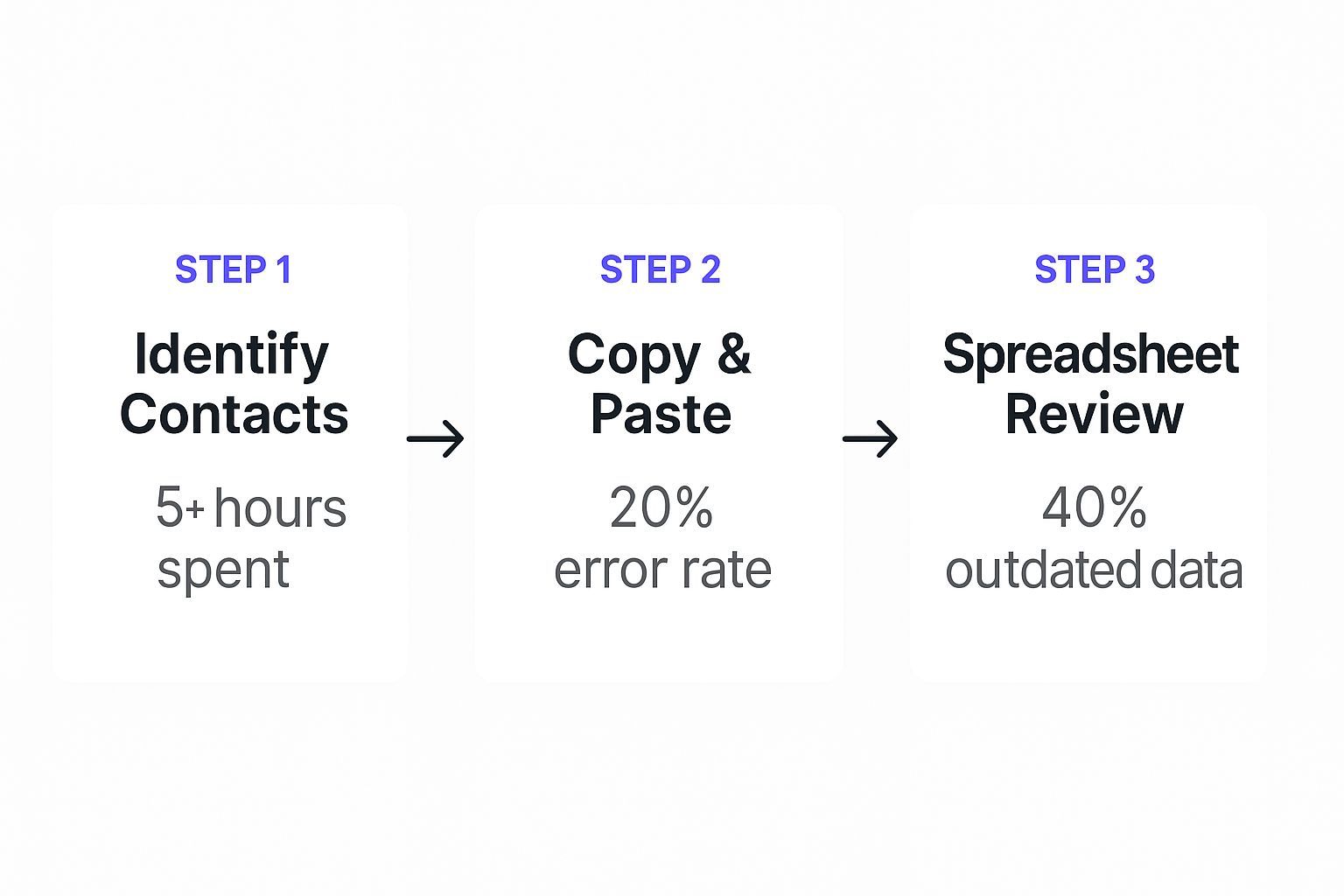In a world of ever-changing algorithms, the single most reliable asset you have for growth is your audience list. It's the fundamental difference between renting a temporary audience on social media and owning a direct, permanent line of communication with your most important contacts.
For recruiters, sales teams, and marketers, this isn't just some passing trend—it's a core strategy for building a resilient, predictable business.
Why Your Audience List Is Your Biggest Asset

Picture this: you've spent years building a massive following on a social media platform. Thousands of people engage with your content, and it's become your primary channel for sourcing leads or candidates. Then, overnight, the platform tweaks its algorithm. Suddenly, your reach plummets. Your posts are now seen by just a fraction of the audience you worked so hard to build.
This isn't just a hypothetical nightmare; it's a reality many professionals face when they rely on "rented" audiences. When you build your presence on someone else's platform, you're building on borrowed land. You don't control the rules, the reach, or even your access to your own followers.
Effective list building is the definitive answer to this problem.
The Power of an Owned Audience
An "owned" audience is simply a list of contacts—emails, phone numbers, professional profiles—that you control directly. This asset is completely immune to algorithm shifts, platform shutdowns, or whatever the latest online trend happens to be. It gives you stability in a constantly changing digital world.
The strategic weight of this asset is only growing. Owning an email list has become a critical business strategy, especially as the ground beneath social media and ad platforms feels increasingly shaky. In fact, the global email marketing market is expected to jump from $14.8 billion in 2025 to $36.3 billion by 2033, which shows just how much value businesses are placing on direct audience communication.
Owned vs. Rented Audiences: A Strategic Comparison
To really grasp why this matters, it's helpful to see the differences side-by-side. This table breaks down the core distinctions between building your own list versus relying on third-party platforms.
| Attribute | Owned Audience (Your List) | Rented Audience (Social Media) |
|---|---|---|
| Control | You have complete control over the list and how you communicate. | The platform dictates access, reach, and the rules of engagement. |
| Communication | Direct, one-to-one messaging with no middleman. | Your visibility is mediated by algorithms you can't control. |
| Longevity | A permanent asset that grows more valuable over time. | Temporary access that can be lost or diminished instantly. |
| Data Access | You own all the contact data for deep segmentation and analysis. | You get limited or no direct access to follower data. |
| ROI | Consistently delivers the highest return on investment of any channel. | Dependent on ad spend and fluctuating organic reach. |
| Risk | Low risk; you aren't dependent on any single platform to survive. | High risk; your business is vulnerable to platform whims and changes. |
The takeaway is clear: investing in an owned audience is about building a stable, long-term asset, while relying on a rented audience leaves you exposed.
What This Means in the Real World
For recruiters, a well-managed list means you have a ready pipeline of qualified candidates to contact, completely independent of any single job board. Sales pros can build hyper-targeted prospect lists for outreach, ensuring their message always gets to the right person, every time.
The ultimate goal isn't just to collect contacts; it's to build a reliable, predictable engine for outreach and relationship management. It's about taking back control of your pipeline.
Ultimately, building your contact list is about creating a solid foundation for your professional life. It ensures your ability to connect with candidates, prospects, or key influencers is never left to chance. With the right strategies and tools, this asset will become the most powerful driver of your success. And if you're ready to get serious about it, exploring the best contact management software is a great place to start.
The Traditional Method: Manual List Building
If you're a recruiter, salesperson, or marketer, you know the grind. Before you can even consider modern solutions, it's worth remembering the painful reality of building a contact list by hand. It's a universal experience: hours spent digging through websites, painstakingly copy-pasting data to build a usable list of people to contact.
Let's walk through a common use case. A recruiter is tasked with sourcing candidates for a specialized software engineering role. Their day is a blur of opening dozens of LinkedIn profiles. For every promising candidate, the manual marathon begins: first name, last name, title, company, location. Then, the real hunt starts—scouring the web for a valid email address or digging through a corporate 'About Us' page to find any contact detail.
Each piece of data is manually dropped into a sprawling spreadsheet. This isn't just slow; it's a massive drain on the energy that should be going into actual relationship-building and conducting interviews.
The True Cost of Manual Data Entry
This old-school approach is more than just a time-sink; it's packed with problems. Human error is practically a given when you're copying and pasting hundreds of data points. A misspelled name or a single transposed digit in a phone number can render that contact useless.
Then there's the data quality issue. People change jobs, on average, every 2-3 years. The contact info you carefully pulled six months ago could easily be obsolete today. This leads directly to bounced emails, wasted outreach, and missed opportunities. This frustrating workflow shows just how much time is wasted and how high the odds of error really are.

The manual process isn't just a slog—it results in a list that’s full of inaccurate or outdated information, severely kneecapping its effectiveness from the start.
A Bottleneck to Growth and Productivity
The real dagger here is the opportunity cost. Every hour your best salesperson spends doing manual data entry is an hour they aren't selling. Every moment a recruiter is stuck in spreadsheet hell is a moment they aren't connecting with a top-tier candidate.
It creates a bottleneck that throttles the entire pipeline. And it doesn't scale. Need to double your outreach? Good luck doubling the manual labor without breaking your budget or your team's morale.
Manual list building forces your most skilled professionals to act as data entry clerks, fundamentally misallocating their talent and hindering their ability to drive real business results.
This approach also locks your hard-won data inside clunky spreadsheets that are a nightmare to manage. Trying to segment those lists for a targeted campaign becomes another painful chore. This outdated way of building lists isn't just an annoyance; it’s a structural flaw that holds businesses back. The time, effort, and sheer number of errors make it painfully clear: a smarter, more automated approach isn't a luxury. It's a necessity.
How AI Is Revolutionizing List Building
The old way of building lists is a soul-crushing grind that turns skilled professionals into data entry clerks. But what if you could shrink that multi-hour process down to a single click? That's exactly where modern, no-code solutions like ProfileSpider change the game. Instead of the tedious manual work, you get a one-click workflow that delivers accurate, organized data instantly.

This is what modern data extraction looks like. ProfileSpider turns a jumble of information on a website into a clean, organized list you can actually use, completely cutting out the manual labor. It's a simple, no-code alternative that frees you up to focus on strategy, not spreadsheets.
From Manual Copy-Paste to Automated Extraction
The traditional list-building workflow is linear, repetitive, and painfully slow. An AI-powered tool flips this entire process on its head, handling detection, extraction, and organization for you.
Instead of seeing a webpage as just text and images, an AI profile extraction tool understands the underlying structure. It intelligently identifies what a "profile" is on any given page—whether it’s a list of conference speakers, a company's team directory, or a LinkedIn search result.
This means you can go to almost any website, click a button, and instantly pull complete professional profiles with names, titles, companies, social links, and contact details. The AI ensures you get accurate data without wasting hours. For a deeper look at the tech, check out our guide on using an AI scraper for smarter data collection.
Universal Application Beyond a Single Platform
One of the biggest headaches with older scraping tools was their narrow focus. Many were hard-coded to work only on LinkedIn, rendering them useless for pulling data from other valuable sources.
Today's AI-powered tools like ProfileSpider are built to be universal. They don't need pre-programmed templates. Instead, their universal extraction engine adapts to different website layouts on the fly, working on LinkedIn, Twitter, GitHub, and any other site with profile information.
This opens up a ton of new possibilities:
- For Recruiters: Build candidate pipelines from niche industry forums or specialized job boards that other tools can't touch.
- For Sales Teams: Pinpoint key decision-makers from a virtual event's attendee list or a corporate "About Us" page.
- For Marketers: Create an influencer database by grabbing profiles from platforms like Twitter, GitHub, or even Behance.
- For Researchers: Easily collect data for market analysis from online directories and community hubs.
The freedom to build hyper-targeted lists from any source gives you a massive advantage.
The Shift to Privacy-First Data Control
A huge red flag with many data collection tools is where your information ends up. When you use a cloud-based service, your extracted data is often sent to their servers, creating serious privacy and compliance issues.
ProfileSpider offers a modern, privacy-first alternative. It keeps all extracted data stored locally in your browser using IndexedDB. This is a critical distinction.
By storing data locally, you maintain complete control and ownership over the profiles you collect. No data is ever sent to external servers without your consent, ensuring you can operate in full compliance with regulations like GDPR.
This local-first model gives you all the power of a sophisticated data tool without sacrificing security. Your lists are your assets, and they stay that way.
Practical Outcomes for Professionals
The impact of this AI-driven, one-click approach is immediate. The conversation shifts from how you're collecting data to what you can do with it.
Consider a sales professional who needs to build a list of 200 marketing managers in a specific city.
- The Old Way: Spend an entire day manually searching LinkedIn, copying profiles one by one, and hunting for contact info. You'll end up with an incomplete spreadsheet full of errors.
- The New Way: Run a targeted search, use a one-click tool like ProfileSpider to extract all 200 profiles in minutes, and export a clean CSV that's ready for your CRM.
The time saved is enormous. It lets that salesperson spend their day actually making calls and sending emails instead of doing mind-numbing data entry. This modern approach to list building delivers accurate data, huge time savings, and incredible flexibility. For another practical way to use AI, this guide on how to build a chatbot for lead generation is a great resource.
Organizing Your Data for Maximum Impact
Pulling in a ton of contacts is a great start, but it’s just that—a start. The real magic happens with what you do next. A messy, disorganized spreadsheet with hundreds of names is more of a headache than an asset. It's impossible to sort through and leads to generic, ineffective outreach that just gets ignored.
The goal is to turn that raw data into a clean, strategic resource. This means shifting your mindset from just collecting profiles to actively curating and sorting them for specific goals.
Beyond the Master Spreadsheet
First things first: ditch the idea of one giant, catch-all list. The most effective outreach today is all about creating smaller, purpose-driven lists.
If you're a recruiter, this could mean having a dedicated "Senior Software Engineer Candidates" list that's totally separate from your "UX Designer Prospects" list. For a sales pro, it might be creating a "Q4 Enterprise Prospects" list that’s distinct from your general "SMB Leads" list.
This approach, called segmentation, isn't just a nice-to-have anymore; it's essential for any successful campaign. The numbers don't lie: recent data for 2025 shows that segmented email campaigns can generate 30% more opens and 50% more click-throughs than the spray-and-pray method. In fact, a whopping 78% of marketers now say segmentation is their most effective email practice. It's all about targeted communication.
Smart Organization with Tags and Filters
Trying to manually create and manage these segmented lists in a spreadsheet is a surefire way to get frustrated. This is where a tool built for this exact purpose, like ProfileSpider, makes the whole workflow seamless. Instead of wrestling with endless columns and rows, you can get way more dynamic with your data.
ProfileSpider’s smart organization features let you:
- Create Custom Lists: Right from the get-go, you can assign extracted profiles to specific lists like "Conference Attendees" or "Competitor Talent Pool" inside the tool. No extra steps.
- Use Custom Tags: Go a level deeper by adding tags. You could tag candidates with specific skills like
JavaorPython, or tag sales leads with labels likeHigh-PriorityorFollow-Up-Q1. - Filter Instantly: Once everything is organized, you can use the advanced search and filtering to pull up the exact profiles you need, right when you need them.
Suddenly, your collection of contacts transforms into a searchable, actionable database that lives right in your browser.
Maintaining Data Hygiene
A clean list is a powerful list. Data hygiene is simply the practice of keeping your contact info accurate and up-to-date. A privacy-first tool like ProfileSpider helps get it right from the start by using AI to ensure accuracy, but the ongoing maintenance is on you.
Your goal should be to build a living database, not a static archive. Regularly review your lists, update contact details as you find new information, and remove outdated entries to keep your outreach sharp and effective.
For instance, if a contact on your "Marketing VPs" list gets a promotion, you can pop into ProfileSpider and quickly edit their job title. It's a small act, but it ensures your next message to them is relevant and well-informed.
Seamlessly Exporting for Action
The final piece of the puzzle is getting your organized data into the systems where you'll actually use it—whether that's a CRM for sales or an Applicant Tracking System (ATS) for recruiting. The handoff needs to be smooth.
ProfileSpider lets you export your neatly organized and tagged lists into professional formats like CSV, JSON, or Excel. You can even customize which fields get exported to perfectly match the import requirements of your CRM or ATS, cutting out all that tedious manual reformatting.
This creates a frictionless workflow from the moment you find a profile to the moment you send your first message. For recruiters, knowing how to create a candidate pipeline and export to Excel can make this whole process even more efficient.
Putting Your New List Into Action

So you've built a perfectly organized list of contacts. That's a great start, but a list just sitting there isn't worth much. Its real value comes alive when you put it to work.
This is where you shift gears from collecting data to building actual relationships. A high-quality list is the fuel for smarter, more personal communication that gets real results—think higher engagement and better conversion rates.
The whole point is to use the detailed information you've gathered to create outreach that's targeted and relevant. No more generic email blasts. Every message should feel like it was written specifically for the person reading it. That thoughtful approach is what separates campaigns that win from those that land in the spam folder.
A Recruiter's Playbook: Sourcing from Niche Communities
Picture this: you're a recruiter trying to find a highly specialized machine learning engineer. You could try LinkedIn, but it's completely saturated. Every top candidate is getting swamped with identical messages.
So, you get clever. You look for a niche online forum where these engineers hang out, discussing new research papers and contributing to open-source projects.
Trying to pull contacts from a forum manually would be a total nightmare. But with a tool like ProfileSpider, you can go to the forum’s member directory or a popular thread and extract the profiles of the most active members with a single click. The tool grabs their names, links to their professional profiles, and any other public info, dropping it all into an instant list you can name "ML Forum Candidates."
Now for the personal touch. You can click into each person's profile, add notes about their specific expertise you saw in the forum, and tag them with skills like PyTorch or TensorFlow. Suddenly, you have a hyper-targeted list ready for a personalized outreach sequence that actually mentions their contributions. That’s how you stand out.
A Sales Team's Playbook: Targeting Conference Attendees
For sales teams, event attendee lists are pure gold. Let's say your company just went to a major industry conference, and the event website has a page listing all the speakers and sponsors. Your mission is to connect with decision-makers from key accounts who were there.
Using ProfileSpider, you can just navigate to that attendee page and pull every single profile into a new list called "Industry Conference Prospects." The tool automatically snags their job titles, company names, and social links. What was once a static webpage is now a dynamic, actionable database.
From there, you can filter this list by job titles containing "Director" or "VP" to zero in on the decision-makers. Once you have that segment, you can export the list straight to your CRM. The result? A pre-qualified list ready for a multi-touch outreach campaign that references your shared experience at the conference, making your follow-up both timely and relevant.
A well-built list transforms anonymous event attendees into warm leads. The context you gain from the source allows for a level of personalization that cold outreach can never match.
A Marketer's Playbook: Building an Influencer Database
When marketers are launching a new product, they need to build buzz, and influencer outreach is a huge piece of that puzzle. Imagine you're launching a new productivity app and need to connect with tech reviewers and content creators on platforms like Twitter and YouTube.
Your first move is to identify potential partners. You can use your toolset to extract profiles from curated lists of "Top Tech Influencers" or even from the follower lists of a major industry publication. Each profile gets saved to a new list called "Productivity App Influencers."
With your initial list built, the real work can begin. You can organize these influencers by their platform, follower count, or engagement rate, using custom tags to manage your workflow. You now have a centralized database to track outreach, manage relationships, and measure the impact of your influencer marketing campaign—all from one clean, organized source.
This kind of organization is essential for nurturing relationships. And when it comes to nurturing, email is still king. Consumers are incredibly engaged with their inboxes—a staggering 88% check their email multiple times a day.
In fact, 60% of consumers actually prefer brands to communicate with them via email over any other channel. This just goes to show how effective a well-built list can be. To really get the most out of your new audience, it's worth exploring potent marketing automation strategies that can skyrocket engagement and drive conversions.
A Few Common Questions About Building Lists
Even with the best tools and a solid game plan, you're bound to have some questions as you dive into building your contact list. Let's tackle some of the most common ones I hear from people just getting started with modern data extraction.
Is It Legal and Ethical to Use Profile Scraping Tools?
This is the big one, and the short answer is: yes, it can be, when done responsibly. Using tools to collect publicly available information is generally acceptable for legitimate business purposes like professional networking, sales prospecting, or recruiting. The key is to always respect the terms of service of any website and comply with data privacy laws like GDPR.
Ethical list building boils down to intent and respect for privacy.
That’s why privacy-first tools like ProfileSpider are a game-changer. It stores all extracted data locally on your computer. You maintain complete control over your data, which is crucial for compliance.
Because the data never touches their servers without your consent, you are the sole controller of that information. This setup prevents accidental data leaks and reinforces ethical, responsible data handling.
How Can I Keep My List Quality from Dropping Off?
It's tempting to go for big numbers, but a smaller, high-quality list will outperform a massive, messy one every single time. Quality over quantity, always.
To keep your standards high, start by getting laser-focused on your ideal customer or candidate profile. Don't just cast a wide net; run highly targeted searches on platforms where you know these people hang out.
Using a modern AI-powered tool is also a must. It dramatically cuts down on the typos and formatting mistakes that inevitably creep in when you’re building lists by hand. Finally, make a habit of cleaning up your list every so often. Verify that contact details are still valid and segment your contacts by job title, industry, or whatever makes sense for you. This keeps your outreach sharp and ensures you're always talking to the right people.
Can a Tool Like ProfileSpider Really Work on Any Website?
Yes, and this is what separates modern, no-code tools from old-school scrapers. Many older tools were built for one specific platform, usually LinkedIn. But today's tools, like ProfileSpider, use a universal AI engine that can understand and adapt to the structure of any website that has professional profiles.
This is a massive advantage. It means you can build a much richer, more diverse contact list without juggling a half-dozen different tools. Think about all the valuable, often overlooked places you can now source contacts from:
- Niche industry forums and communities
- Corporate "About Us" and leadership pages
- Speaker and attendee lists from virtual events
- Specialized social networks that aren't the usual suspects
This kind of flexibility gives you a serious edge. You can find highly relevant people in places your competitors probably aren't even looking.



